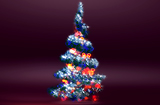Christmas Trees
Enjoy these holiday decorations in a safe and environmentally friendly way.
Real vs. Artificial
In general, artificial trees are less messy and easier to put up than real trees. They can also be healthier for your family, since some children may be allergic to real trees. Artificial trees can be higher-priced than real trees, but they can also be reused for many years.
Unfortunately, most artificial trees end up in landfills when they go out of style or become worn. Real cut trees can be recycled or used in compost piles.
Living Trees
A living Christmas tree--with roots still attached--is an environmentally friendly version of the traditional Christmas tree. You can select from a variety of living trees. Species well-adapted for Florida include red cedar, Arizona cypress, sand pine, and junipers. Other tree species are not suited for Florida’s climate, so before you pick out your tree, find out what kind it is.
After the holidays are over, you can plant the tree in your yard. Fortunately, January is the best time to plant trees in Florida. For more information about tree identification and planting, check with your county Extension office.
Don’t try to find your live Christmas tree in your yard or the woods. Digging up live trees can cause transplant shock, and the tree will probably die. Wild trees are also unlikely to have the classic Christmas tree shape.
Many nurseries grow Christmas trees in containers. These trees can be brought inside the house and decorated just like cut real trees or artificial trees. Be sure to keep the soil in the container moist so that the tree keeps growing. The container will add some height to the tree, so make sure that you buy a tree that can fit in your home.
If you don’t have space for a full-size tree, consider placing a smaller container plant on a tabletop. You can keep the plant on a patio or deck during the remainder of the year and bring it inside to decorate for the holidays.
Choosing Your Tree
Know the size and height of the area where you want to put the tree. You don’t want to buy a tree that’s too big for your house!
You can purchase a cut real tree in a retail shop or tent sale, or you can pick out your own tree at a U-cut tree farm. Artificial trees of varying sizes and styles can also be found at many retail stores.
If you're buying a real tree and plan to decorate it, choose a pine or fir variety--the stronger branches of these species can support heavy ornaments.
When buying a cut tree, choose one that has a strong scent and looks fresh and green. Thump the trunk on the ground to shake off any loose needles. If the tree loses a lot of needles, you may want to choose a different one. Have the stump cut at the tree lot.
Maintaining Your Tree
Pine needles begin to fall off more frequently as the tree dries out. Put the tree into a sturdy tree stand, fill the base with water, and keep it full at all times.
A cut stump allows the tree to absorb water more quickly, keeping the tree moist and delaying needle drop. Moist trees are also less likely to catch fire. Keep your tree away from heat sources that can dry it out.
To make cleanup easier, place a tree skirt or cloth around the tree so that dropped needles do not fall onto the floor.
Safety
Fire
In a recent study, a suburban Detroit fire department demonstrated that a well maintained real tree was more fire resistant than an artificial variety. Although the artificial tree was advertised as fire retardant, it was eventually engulfed in flames. The artificial tree also produced toxic smoke while burning. The real tree remained mostly intact after the fire, but the artificial tree melted almost completely.
To prevent your tree from catching fire, keep it well away from fireplaces, radiators, and other heat sources.
Candles & Lights
Never put lighted candles on your Christmas tree. The effect may be pretty, but the flames can easily set the tree on fire. For a similar look, use strings of lights.
Only use indoor lights on your tree. Before you put the lights on the tree, check for broken or cracked sockets, frayed or bare wires, or loose connections. If a light string is damaged in any way, repair or replace it. Don’t plug more than three light sets into any one extension cord. Turn off all tree lights and decorations when you go to bed or leave the house.
Disposal
To avoid a fire hazard, throw your real tree out when it becomes dry. Experts recommend removing the tree from your home by New Year's Day.
Never burn tree branches or needles in a fireplace or woodburning stove. Be environmentally friendly by taking your tree to a recycling center. A community pick-up service may be available to haul the tree away for you.
Compiled from:
Buy A Real Christmas Tree! by Dan Culbert (rev. 11/2006).
Christmas Tree Selection and Care by Bob Black.

Related Sites & Articles
- Christmas Tree Fire Hazards--U.S. Fire Administration
- Christmas Tree Tips--National Safety Council
- Christmas Tree Varieties
- Christmas Trees & More--University of Illinois Extension
- Fire Safety for the Holidays--National Institute of Standards and Technology
- Florida Christmas Tree Association
- National Christmas Tree Association
- Tabletop Christmas Trees

